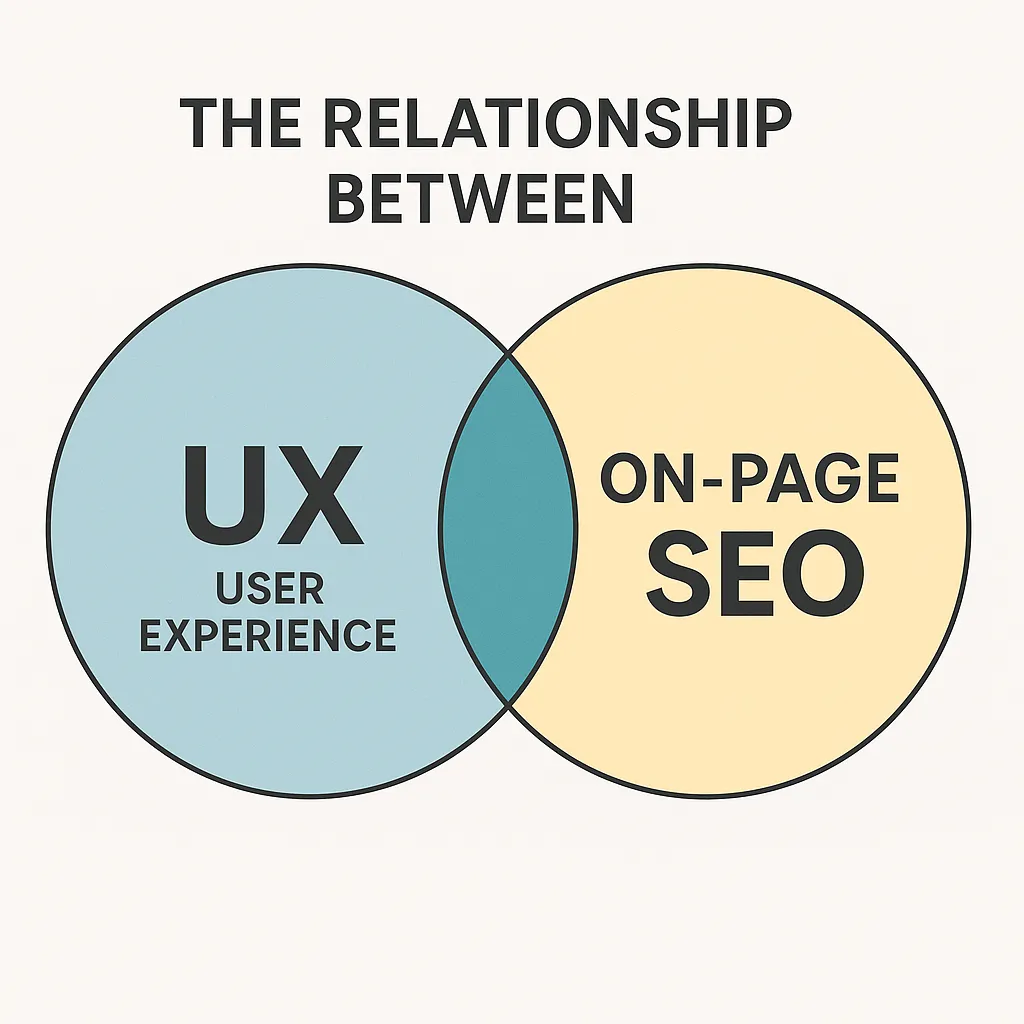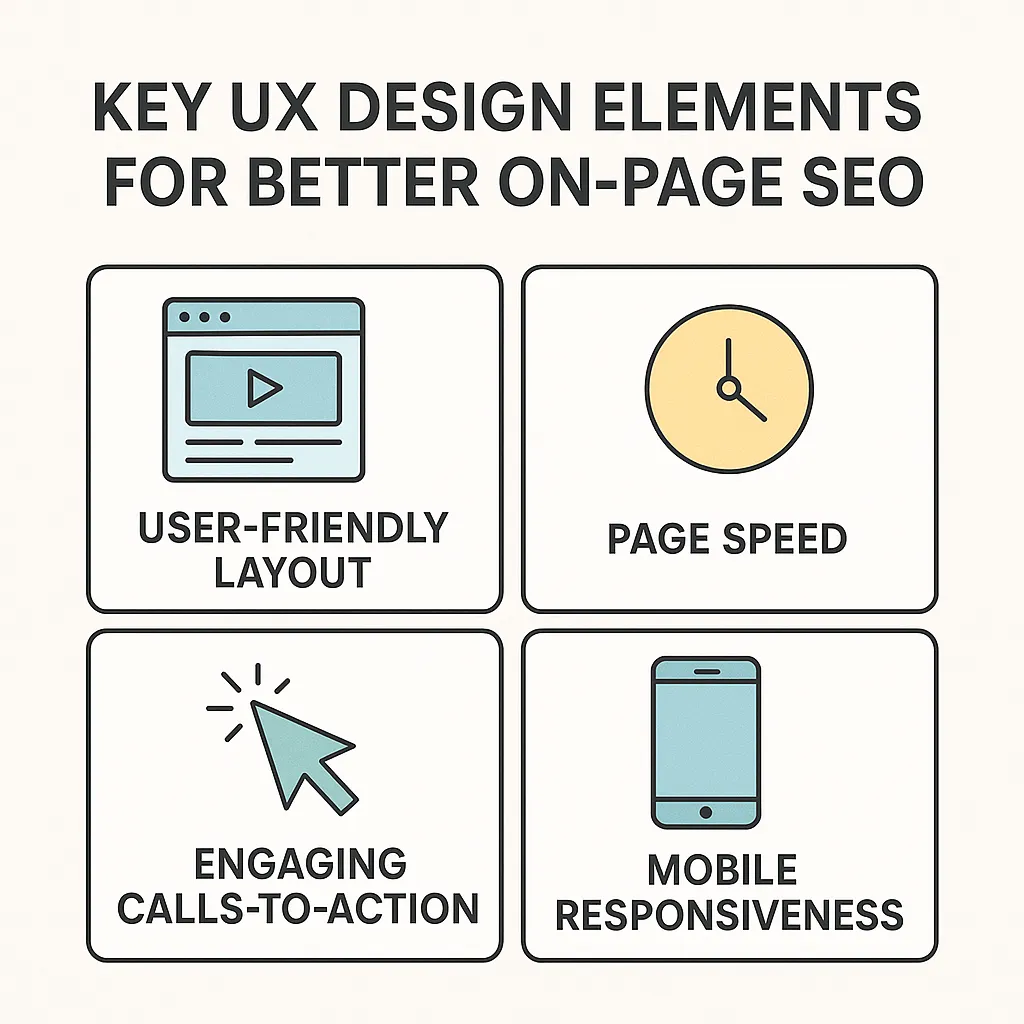In today’s competitive search environment, delivering high quality content is no longer enough. Search engines like Google now evaluate how users interact with your site as a core part of determining your SEO ranking.
This shift places User Experience SEO at the center of modern optimization strategies. From page layout to engagement metrics, UX and SEO are more connected than ever before.
This article explores how improving user engagement SEO and applying smart SEO ux design principles can significantly impact your google search ranking and more importantly, create a better experience for your audience.
1. What Is User Experience in the Context of SEO?
In the past, on page SEO was mainly associated with keywords, meta tags, and internal links. Today, that picture is incomplete without User Experience SEO. Search engines have evolved to evaluate not just what your content says, but how it performs in the hands of real users. Understanding UX in an SEO context means considering how users perceive, interact with, and navigate your site and how these interactions impact your SEO ranking.
Defining UX from an SEO Perspective
From an SEO standpoint, user experience refers to how easily and efficiently a visitor can interact with your site. This includes everything from site speed and mobile responsiveness to readability and content clarity. Good UX ensures that users find what they need quickly, without frustration or confusion an outcome that search engines now actively reward.
In this context, UX and SEO are no longer separate disciplines. SEO brings users to the site; UX determines whether they stay and engage. Both must work together to deliver sustained visibility and performance.
Why UX Matters for Google’s Search Algorithms
Google’s algorithm has shifted dramatically over the past few years, particularly with updates like RankBrain and the introduction of Page Experience Signals. These updates prioritize how real users interact with content, and not just how well that content is optimized with keywords.
When users spend more time on your site, click deeper into your content, or interact meaningfully, Google sees it as a positive sign. On the flip side, high bounce rates or confusing layouts signal poor user engagement SEO hurting your chances of ranking well.
How UX Shapes SEO ranking and Visibility
Strong user experience can significantly improve your site’s visibility in search. Here’s how:
- Better engagement metrics (e.g., dwell time, click through rate) signal relevance
- Faster loading times and mobile responsiveness reduce bounce rates
- Clear navigation and structure make it easier for bots and users to explore your site
Ultimately, sites that are both user centric and technically sound are more likely to secure higher SEO ranking and maintain long term authority.
2. The Relationship Between UX and On Page SEO
As search engines become more sophisticated, the boundaries between UX and SEO continue to blur. On page SEO is no longer just about placing keywords it's about how users experience each page. A well optimized site that fails to deliver smooth navigation, fast loading, and clarity of information won’t rank well for long. In this section, we explore the strategic link between SEO and user experience and how one empowers the other.

Connecting UX and SEO: A Strategic Overview
The purpose of SEO is to attract visitors. The purpose of UX is to keep them engaged.
When these two disciplines are aligned, the results compound:
- SEO drives qualified traffic
- UX ensures those visitors stay, engage, and convert
User Experience SEO isn’t a luxury it’s an expectation. From intuitive page design to fast page loads, search engines reward the same things users appreciate. In essence, on page SEO has evolved into a broader, user centric optimization framework.
Why SEO and user experience Must Be Aligned
If your content ranks high but users leave quickly, the algorithm takes notice. Bounce rates go up. Time on page goes down. And eventually, so does your SEO ranking.
That’s why SEO and user experience must be considered together, not in silos. Optimizing title tags and meta descriptions without addressing mobile usability or poor layout creates a fragmented strategy. Google is now tracking engagement metrics closely and penalizing poor UX accordingly.
User engagement SEO Metrics That Matter Most
The following behavioral metrics offer direct insight into how UX supports or hinders your SEO performance:
- Bounce Rate: High rates often signal poor content relevance or frustrating design.
- Dwell Time: More time on page generally reflects better user experience.
- Pages per Session: Well structured sites guide users naturally from one page to the next.
- Click Through Rate (CTR): Strong meta copy and UX alignment encourage clicks from SERPs.
Monitoring and improving these metrics is essential for modern User Experience SEO strategies.
3. UX Signals That Influence SEO Ranking Factors
Search engines have grown more capable of interpreting how users interact with web content. As a result, specific behavioral signals now contribute directly to SEO ranking factors. These signals are essential indicators of how valuable and usable a page truly is.
The Role of Bounce Rate, Dwell Time, and CTR
Among the most influential user engagement SEO signals are:
- Bounce Rate: A high bounce rate may indicate irrelevant content or frustrating UX. Pages with smoother flow and better relevance reduce this metric.
- Dwell Time: This reflects how long users remain on a page. A higher dwell time typically means more valuable, engaging content and intuitive design.
- Click Through Rate (CTR): Good UX starts from the search results. Titles and meta descriptions that align with user intent and offer value drive higher CTRs boosting google search ranking.
Google doesn’t view these metrics in isolation; instead, they’re interpreted in context to determine content quality and usability.
How Improve website UX Impacts google ranking
A well optimized user experience doesn’t just keep visitors happy it improves your site’s position in search. Here’s how enhancing UX directly affects google ranking:
- Improves page load speed and minimizes interaction delays
- Reduces abandonment due to confusing navigation or clutter
- Encourages deep content exploration, lowering bounce rates
- Increases return visits and repeat engagement
When you improve website UX, you’re strengthening the exact signals Google’s algorithm values most.
Mobile Responsiveness, Navigation & Layout Flow
With Google’s mobile first indexing, mobile responsiveness is no longer optional it’s critical. Combined with clear layout flow and smart navigation, these UX components make your content easier to consume, particularly on smaller devices.
- Ensure tap targets are sized properly
- Use collapsible menus and sticky headers wisely
- Guide users through logical paths with intuitive layout sequencing
Sites that are mobile friendly and structured around clean navigation hierarchies tend to perform better across all SEO ranking factors.
4. Key UX Design Elements for Better On Page SEO
When it comes to on page SEO, design isn’t just aesthetics it’s structure, flow, and clarity. Smart UX design can enhance crawlability, readability, and conversion, all while aligning with SEO ux design principles.

SEO UX design Principles That Actually Work
Great SEO ux design is built around simplicity and intentionality:
- Use semantic HTML to ensure content structure is understood by both users and search engines
- Prioritize above the fold value to capture attention immediately
- Apply consistent styling for predictability and brand trust
These practices improve indexing and user satisfaction simultaneously, aligning with both UX and on page SEO goals.
Enhancing Readability and Content Structure
Well organized content helps users scan and digest information efficiently:
- Use short paragraphs, clear headings, and bullet points
- Choose legible font sizes and maintain strong contrast ratios
- Break long pages into logical sections with clear topic transitions
Improved readability leads to longer sessions, reduced bounce, and higher user engagement SEO performance.
Visual Hierarchy and Conversion Driven Layouts
A strong visual hierarchy guides the user’s eye from the most important elements down to supportive details. This approach increases:
- Time on page
- Engagement with CTAs
- Likelihood of conversion
Strategic placement of call to actions, smart spacing, and focused visual flow turn passive visitors into active users contributing positively to SEO ranking factors and business outcomes alike.
5. Tools and Techniques to Evaluate SEO UX Performance
Optimizing User Experience SEO begins with understanding how users behave on your site. Without actionable data, improvements are based on assumptions. The following tools and methods help you collect, analyze, and act on UX data that impacts on page SEO performance.
Tracking UX with Heatmaps, Analytics & GSC
Visual and behavioral tracking tools are essential for analyzing real user activity:
- Heatmaps (via tools like Hotjar or Crazy Egg): Show where users click, scroll, and lose attention
- Session recordings: Reveal patterns of frustration, hesitation, or exit behavior
- Google Analytics: Provides bounce rates, session duration, and pages per session
- Google Search Console (GSC): Offers insights on search performance, Core Web Vitals, and mobile usability
Together, these tools help identify the why behind weak user engagement SEO metrics.
Useful Tools for SEO user experience Optimization
There are several dedicated platforms that bridge the gap between UX and SEO by focusing on both technical and behavioral performance:
- PageSpeed Insights – Assesses load times and performance issues tied to UX
- Lighthouse (in Chrome DevTools) – Runs audits for accessibility, speed, and structure
- Microsoft Clarity – Free session tracking and heatmap analytics
These tools help prioritize fixes that enhance SEO user experience holistically.
Using A/B Testing to Improve user engagement SEO
A/B testing is a powerful technique to experiment with variations in layout, CTA placement, content length, and visuals. To improve user engagement SEO:
- Test changes to page headers, button colors, or content blocks
- Measure outcomes like dwell time, clicks, and form submissions
- Use platforms like Optimizely, Google Optimize (sunset, but alternatives exist), or VWO
What works for design should also serve SEO. Continuous experimentation ensures your UX evolves based on real user behavior not assumptions leading to better engagement and stronger SEO ranking.
6. Best Practices to Improve Website UX for SEO Success
Creating a seamless, engaging user experience isn’t just good for your audience it’s essential for maintaining competitive SEO ranking. Implementing proven UX best practices can directly enhance your site’s performance and signal to search engines that your content deserves to be seen.

Design Patterns That Align with SEO ranking factors
Some UX design approaches naturally complement SEO ranking factors. These patterns improve both user satisfaction and algorithmic favorability:
- Clear visual hierarchy: Helps users and crawlers understand content priorities
- Consistent navigation structure: Supports internal linking and crawl depth
- Breadcrumbs and section based layouts: Improve orientation and reduce bounce
- Expandable content (like FAQs): Adds value without overwhelming the interface
These elements contribute to better user engagement SEO by making content easier to find, read, and act upon.
Accessibility, Speed, and Mobile First Strategy
Google emphasizes inclusive design and performance across devices. Prioritizing these three aspects of UX supports stronger rankings:
- Accessibility: Use proper alt text, keyboard navigation, and color contrast
- Speed: Compress images, limit third party scripts, and defer non critical assets
- Mobile First Design: Ensure fast, frictionless interaction on smaller screens
Together, these factors align with google search ranking criteria and improve long term visibility.
Common Mistakes to Avoid in SEO ux design
Even well intentioned designs can hurt performance if misapplied. Key mistakes to avoid:
- Overcomplicated layouts that confuse both users and crawlers
- Intrusive pop ups that disrupt flow and frustrate mobile users
- Poor typography or spacing that reduces readability
- Inconsistent CTA placement leading to low conversions
Maintaining clean, consistent, and focused design ensures your SEO ux design efforts lead to measurable results not missed opportunities.
7. Final Thoughts and Actionable Takeaways
In a digital environment where every click matters, aligning user experience with on page SEO is no longer optional it’s strategic. Prioritizing usability, design clarity, and mobile performance helps your content not only rank better but truly resonate with users.
Summary of Key UX SEO Strategies
To maximize the impact of User Experience SEO, focus on the following proven strategies:
- Optimize for fast page speed and mobile first design
- Use clean, accessible layouts that support user flow
- Monitor behavioral signals like bounce rate and dwell time
- Apply consistent SEO ux design principles for structure and clarity
- Leverage data from heatmaps, GSC, and A/B testing to drive decisions
These tactics improve both your SEO ranking and the overall satisfaction of your visitors.
When to Prioritize UX and SEO Improvements
You should prioritize UX and SEO updates when:
- Organic traffic is stable but engagement is low
- Bounce rates are rising without technical errors
- You’re launching a redesign or adding new content sections
- Mobile performance is underperforming in Google Search Console
Knowing when to act is just as important as knowing what to fix.
Building a Future Proof User Experience SEO Plan
Future proofing your SEO means designing with people first. Here’s how:
- Align UX and SEO teams early in the strategy phase
- Use modular, scalable design systems that can evolve
- Stay updated on Google’s algorithm changes especially around SEO and user experience
- Build testing and feedback loops into your ongoing workflow
By building around user needs and algorithmic expectations, you create a foundation for lasting success in both search and experience.
8. Summary
The connection between user experience and on page SEO has become one of the most influential factors in how websites perform in search results. As Google’s algorithms increasingly prioritize engagement, speed, and usability, businesses must adapt by aligning their content strategies with thoughtful, data driven design.
Improving User Experience SEO involves more than just visual design it requires optimizing for performance metrics, clear navigation, mobile responsiveness, and meaningful content flow. Behavioral signals like bounce rate, dwell time, and click through rates now play a direct role in shaping your SEO ranking.
To succeed long term, brands should focus on:
- Applying consistent SEO ux design principles
- Using analytics and heatmaps to track engagement
- Prioritizing mobile first and accessible design
- Avoiding UX mistakes that hurt discoverability
- Building strategies that align both SEO and UX goals
When you improve website UX with intention and precision, you're not just creating a better user journey you’re also increasing visibility, trust, and long term growth potential in the search ecosystem.

